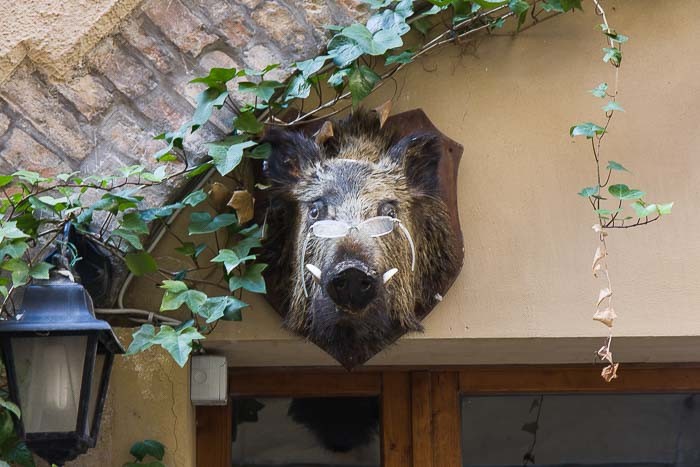Tuscany and Why You Need to Eat the Wild Boar
If there was a single animal who seems to represent Tuscany, it would have to be Sus scrofa, the Wild Boar. Cinghiale, as it's called in Italian, is tasty (when young), so you find it on many restaurant menus. They are also quite destructive; when rooting out grubs and other tasty tidbits with a plow-like head, overdeveloped canines and powerful neck muscles, boars can make shambles of large chunks of vineyard, a hot spot for gourmet hordes of wild pig. This makes vineyard owners hopping mad, of course. Because of this destructiveness--and because a boar is a challenge to kill, it is hunted with particular vigor. Problem is, the beast breeds more prolifically than hunters, who are their last remaining major predators on the Italian peninsula.
Thus: if you like wine, you will come to Tuscany to eat Wild Boar. It is your duty.
When you see the head of a boar placed over the entrance of a Tuscan restaurant, you can choose one of two intended meanings:
- Ah, the restaurant features the traditional foods of the region and pays respect to its fearless hunters!
- Tourists think this is cute, and will come in droves.

Besides vineyards, the wild boar's feasting can raise the hackles of villagers who produce other food staples. Shortly after we bought our house in northern Tuscany, we arrived one fall day and were startled by exposions exactly synchronized to 20 minute intervals, which continued through the night. The next day we asked our neighbor Enrico what was going on.
He looked bored and waved his hand in the air. "Ah, that. It's just another of Bush's wars." Then, while we were chuckling over his pronunciation of then-president Bush's name as "Booooosh," he told us the real reason: a cannon had been set up on the hillside in hopes of driving away the wild boar, who absolutely loved the polenta corn growing in the fields around out little village.
Paired with nearly every order of wild boar stew in Tuscany is a polenta, so you get the irony, right?
So you should eat boar not only to save the vineyards but also to save the special breed of polenta corn grown in the Lunigana and Garfagnana in northern Tuscany.
A tourist has many responsibilities, but none so tasty as this.
How is Wild Boar Prepared in Tuscany?
Boar is a tasty animal, but when a boar gets older, the taste can get overwhelmingly "gamey". Since a hunter can't usually choose the age of the kill, Tuscans seem to take measures to offset the occasional strong flavors by lacing the stew with very strongly flavored ingredients just in case. Chocolate and dried fruits are often used. In some ways this is a shame, because it covers the fine taste of young boar who've eaten bland things like corn.
A typical traditional Tuscan recipe from Divina Cucina is called Cinghiale in Agro Dolce or Dolce Forte Marinade. It uses pumpkin pie spices in the red wine marinade. Bittersweet chocolate, pine nuts and dried prunes are added to the sauce after the meat has cooked. Doce Forte (strong sweet) indeed.
My Top Wild Boar Dish in Tuscany
So far, the best tasting wild boar (cinghiale) dish I've had was at a restaurant near the market in Pisa called Trattoria Vineria di Piazza. There's no menu, they just serve a few dishes based on what's fresh in the market. They had a choice of wild boar "dolceforte" or with olives. I got the olive version and it was fantastic.
Trattoria Vineria di Piazza
Piazza delle Vettovaglie 14, Pisa
The dish is pictured below. Like many Italian dishes, it ain't much to look at, but oh, my, does it taste good.

More on Tuscany for Tourists
Find out more about Tuscany and the region's food and history.
Learn about cinghiali and the Italian Language associated with the beasts.
Take a cooking class in a Tuscan Castle.

